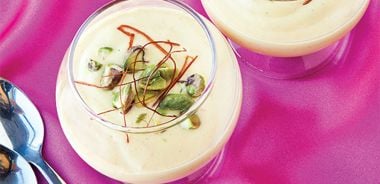Mango Cream Ambrosia

This creamy Indian dessert is traditionally known as shrikhand, meaning “food of the Gods,” and comes in a number of variations depending on the particular region in which it’s made. The lovely luscious melon colour makes it a sweet treat as pleasing to the eye as it is to the tongue. Try topping it with a few strands of saffron and pistachios—it is also excellent with sliced fruit, such as mango or peach slices, and blueberries.
1/4 cup (60 mL) raw golden sugar
Generous pinch of saffron threads
2 cups (500 mL) 0% fat plain Greek yogurt
1 ripe mango, peeled, pitted, and diced
Generous pinches of cinnamon
Pinch of freshly grated nutmeg
Pinch of ground cardamom
1/4 cup (60 mL) finely chopped toasted pistachios
Saffron strands (optional)
Finely grind sugar to powder. Place in small saucepan with 1/2 cup (125 mL) water. Stir to dissolve sugar. Bring to boil over medium heat, stirring occasionally until reduced to 1/4 cup (60 mL). Remove from heat and cool slightly. Add generous pinch of saffron, rubbing threads into sauce with your fingertips. Set aside to cool thoroughly.
Combine yogurt, mango, cinnamon, nutmeg, cardamom, and cooled syrup in blender. Whirl until smooth and creamy. Can be covered and refrigerated overnight and served the next day. Spoon into dessert bowls; sprinkle with pistachios and a couple strands of saffron if you wish.
Serves 4.
Each serving contains: 189 calories; 8 g protein; 6 g total fat (2 g sat. fat, 0 g trans fat); 28 g total carbohydrates (26 g sugars, 2 g fibre); 90 mg sodium
source: "Celebrate Diwali", alive #373, November 2013





